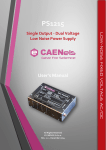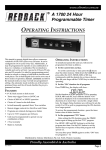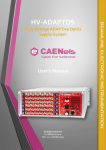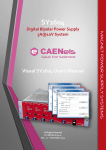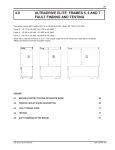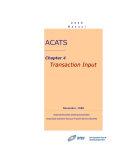Download CT-200/CT-300/CT-400 Series User`s Manual
Transcript
DC Current Transducers CT-200 CT-300 CT-400 User’s Manual All Rights Reserved © CAEN ELS d.o.o. Rev. 1.0 – November 2014 PRECISION CURRENT TRANSDUCERS < CT-200/CT-300/CT-400 User’s Manual CAEN ELS d.o.o. Kraška ulica, 2 6210 Sežana – Slovenija Mail: [email protected] Web: www.caenels.com 2 CT-200/CT-300/CT-400 User’s Manual Table Of Contents 1. INTRODUCTION................................................................................................ 9 1.1 1.2 2. < CURRENT TRANSDUCERS OVERVIEW ..................................................... 9 CT-200/CT-300/CT-400 MODELS AND VERSIONS ....................................... 10 INSTALLATION AND OPERATION ............................................................ 12 2.1 MECHANICAL CONSIDERATIONS ................................................................... 12 2.2 CONNECTOR PINOUT ..................................................................................... 13 2.3 SECONDARY-SIDE SIGNALS ........................................................................... 14 2.3.1 Power Supply ........................................................................................... 14 2.3.2 Secondary Current (current versions only) ............................................. 14 2.3.3 Voltage Output (“V” versions only) ........................................................ 14 2.3.4 STATUS Signal......................................................................................... 15 2.4 MOUNTING.................................................................................................... 17 2.5 PRIMARY CURRENT PATH ............................................................................. 18 2.6 FULL-SCALE CURRENT ................................................................................. 19 3. ORDERING OPTIONS..................................................................................... 20 4. TECHNICAL SPECIFICATIONS .................................................................. 21 4.1 4.2 4.3 5. EQUIVALENT INPUT NOISE ............................................................................ 22 INSULATION CHARACTERISTICS .................................................................... 24 EXTERNAL SHUNT RESISTOR ........................................................................ 25 MECHANICAL DIMENSIONS....................................................................... 27 3 CT-200/CT-300/CT-400 User’s Manual Document Revisions Document Revision 1.0 Date September 16th 2014 1.1 September 23th 2014 1.2 November 3rd 2014 4 Comment Document created Added power supply recommendation section Manual graphics changed CT-200/CT-300/CT-400 User’s Manual PS1215 – Power Supply Recommendations We strongly recommend using this product with the CAEN ELS PS1215 power supply, which has been especially deigned in order to obtain low-noise operation and it is suited for DCCT measurement system where switching power supplies could corrupt measuring accuracy, precision and noise. BNC connection for Voltage-Output DCCT “Power Good” LED monitors DCCT side SUB-D connector AC Line Input The power supply is available in two different versions, one to be used with the current-output DCCTs and one with the voltage-output ones (the PS1215V is shown in the previous image): Product Code Description WPS1215VXAAA PS1215V - AC/DC Single Output - Dual Voltage ±15V Low Noise Power Supply - 27W max - 3m cable with DB-9 and BNC (Voltage Output) WPS1215IXAAA PS1215I - AC/DC Single Output - Dual Voltage ±15V Low Noise Power Supply - 27W max - 3m cable with DB-9 and banana plugs (Current Output) For more information or further details please refer to the PS1215 User’s Manual. 5 CT-200/CT-300/CT-400 User’s Manual Safety information - Warnings CAEN ELS will repair or replace any product within the guarantee period if the Guarantor declares that the product is defective due to workmanship or materials and has not been caused by mishandling, negligence on behalf of the User, accident or any abnormal conditions or operations. Please read carefully the manual before operating any part of the instrument WARNING Do NOT open the boxes CAEN ELS d.o.o. declines all responsibility for damages or injuries caused by an improper use of the Modules due to negligence on behalf of the User. It is strongly recommended to read thoroughly this User's Manual before any kind of operation. CAEN ELS d.o.o. reserves the right to change partially or entirely the contents of this Manual at any time and without giving any notice. Disposal of the Product The product must never be dumped in the Municipal Waste. Please check your local regulations for disposal of electronics products. 6 CT-200/CT-300/CT-400 User’s Manual Read over the instruction manual carefully before using the instrument. The following precautions should be strictly observed before using the device: WARNING CAUTION Do not use this product in any manner not specified by the manufacturer. The protective features of this product may be impaired if it is used in a manner not specified in this manual. Do not use the device if it is damaged. Before you use the device, inspect the instrument for possible cracks or breaks before each use. Do not operate the device around explosives gas, vapor or dust. Always use the device with the cables provided. Turn off the device before establishing any connection. Do not operate the device with the cover removed or loosened. Do not install substitute parts or perform any unauthorized modification to the product. Return the product to the manufacturer for service and repair to ensure that safety features are maintained This instrument is designed for indoor use and in area with low condensation. 7 CT-200/CT-300/CT-400 User’s Manual The following table shows the general environmental requirements for a correct operation of the instrument: 8 Environmental Conditions Requirements Operating Temperature 0°C to 50°C Operating Humidity 30% to 85% RH (non-condensing) Storage Temperature -10°C to 60°C Storage Humidity 5% to 90% RH (non-condensing) CT-200/CT-300/CT-400 User’s Manual Introduction 1. Introduction This chapter describes the general characteristics and main features of the < current transducers. 1.1 < Current Transducers Overview The < current transducers family is based on a closed loop technology that allows accurate and precise monitoring of DC and AC currents with high bandwidth. Main characteristics of the entire < family are negligible temperature coefficient, excellent linearity and extremely low noise. The transducers CT-Series family has a transform ratio between primary and secondary. The transform ratio value depends over the CT-Series model. External plastic casing guarantees galvanic isolation between the primary and the secondary circuits in order to allow to current measurements at a different potential and simplifies interfacing when using the < , as the feedback element of current regulated power supplies. The internal conductive casing guarantees higher noise immunity and reduces undesired noise pick-up from external sources. DC current transformers and transducers represent the ideal replacement for systems where Hall-effect sensors or shunt resistors are used as current sensing elements and better performances are needed. Main application fields for these current transducers are precise and extremely stable regulated power supplies and power inverters. Due to the excellent characteristics, the < transformers can be used in a variety of calibration, acceptance testing and quality control applications in the industrial and automotive fields. 9 CT-200/CT-300/CT-400 User’s Manual Introduction 1.2 CT-200/CT-300/CT-400 Models and Versions The CT-200, CT-300 and CT-400 current transducers are available in two different versions that differ by the output type: standard secondary current output or buffered voltage output, where low temperature coefficient shunt resistor and lownoise amplifier are embedded in the internal electronics in the “V” model. Connections for power supply and output signals are available through a standard D-SUB connector (also known as “DE-9”). The different models and versions of the CT-200, CT-300 and CT-400 are summarized in the following table (Table 1): Product Code Model Description WCT200XAAAAA CT-200 200 A Primary Current < , Current-Output WCT200VXAAAA CT-200V 200 A Primary Current < , Voltage-Output WCT300XAAAAA CT-300 300 A Primary Current < , Current-Output WCT300VXAAAA CT-300V 300 A Primary Current < , Voltage-Output WCT400XAAAAA CT-400 400 A Primary Current < , Current-Output WCT400VXAAAA CT-400V 400 A Primary Current < , Voltage-Output Table 1: CT-200, CT-300 and CT-400 versions and models The CT-Series transducer with the current output acts mainly as a transformer (with DC capability) that converts a full-scale bipolar primary current to a secondary current up to ±400 mA. The CT-200, CT-300 and CT-400 have a maximum secondary output current of ±200 mA. The voltage-output “V” version converts the primary bipolar full-scale current to a secondary output voltage of ±10 V. 10 CT-200/CT-300/CT-400 User’s Manual Introduction Front view of a CT-200/CT-300/CT-400 current transducer is presented in Figure 1. Figure 1: front view of a CT-200, CT-300 or CT-400 < current transducer Rear view of the same current transducer, where self-threading holes for screws are visible, is presented in Figure 2. Figure 2: rear view of a CT-200, CT-300 or CT-400 < current transducer 11 CT-200/CT-300/CT-400 User’s Manual Installation and Operation 2. Installation and Operation General considerations and description of pinout and functionalities are herein presented. 2.1 Mechanical Considerations Each version of the CT-Series current transducer presents an embossed “arrow” with the CAEN ELS logo on one side of the plastic casing that indicates the verse of the positive primary current measurement. This arrow can be seen in Figure 3 on the right side of the enclosure. Embossed arrow indicating the verse of positive primary current Positive Current Negative Current Figure 3: embossed arrow indicating the verse of positive primary current 12 CT-200/CT-300/CT-400 User’s Manual Installation and Operation 2.2 Connector Pinout The CT-200, CT-300 and CT-400 have a standard D-SUB 9-pin (or, commonly referred to as “DE-9”) in both their current output and voltage output versions. The standard pin numbering to refer to is herein presented in Figure 4. Pin #9 Pin #6 Pin #5 Pin #1 Figure 4: D-sub 9 connector pin numbering The pinout for the two versions are presented in Table 2. These two versions have current or voltage output pins (and their signal returns). Pin # CT-200, CT-300, CT-400 (Current Output) CT-200V, CT-300V, CT-400V (Voltage Output) 1 IS return nc - GND 2 nc VOUT 3 Status - 4 GND 5 -15V 6 IS Internal Use 7 nc VOUT return 8 Status + 9 +15V Table 2: CT-200, CT-300 and CT-400 pinout Please note that pins not internally connected on the specific model are indicated in Table 2 as nc = not connected. Please DO NOT connect any signal to the pins indicated as Internal Use. 13 Installation and Operation CT-200/CT-300/CT-400 User’s Manual 2.3 Secondary-side Signals The signals on the “secondary” side of the CT-200, CT-300 and CT-400 current transducers are found on pins #1, 2, 3, 6, 7 and 8 (please note that not all of them are present on all versions) of the DE-9 connector. 2.3.1 Power Supply Supply voltages for the CT-200, CT-300 and CT-400 have to be fed to pin #9 (+15V) and to pin #5 (-15V) of the D-sub 9-pin connector; both these voltages are referred to pin #4 (GND). Maximum current that can be drawn from each one of these supply voltages is of 250 mA for all three models – i.e. CT-200, CT-300 and CT-400 (a maximum of 50 mA for supplying the internal electronics circuits and a maximum of 200 mA for the secondary current). 2.3.2 Secondary Current (current versions only) On the “standard” current output versions the secondary current output IS, scaled by its current transformation ratio is fed to pin #6. Current return pins are respectively found on pin #1 and on pin #7. Maximum secondary current depends over the full-scale range and the current transform ratio of the sensor. For example for a CT-200 the full-scale range is ±200 A and its transformation ratio is 1:1000, thus its maximum secondary current is rated at ±200 mA. An external shunt resistor, which can be placed close to the user’s desired measuring circuit (to avoid the noise pick-up), is needed in order to convert the current signal to a voltage. The voltage output pins (VO and VO RET) cannot be found on standard current output versions. 2.3.3 Voltage Output (“V” versions only) A buffered output voltage signal is present on the voltage output versions of the transducers in order to allow easier connection of the DCCT to an external circuit or an Analog to Digital converter (ADC). The full-scale output bipolar signal VO (pin #2 for “V”-version) is referred to VO RET (pin #7) and the behavior is as follows: 14 +10V output if the primary current is equal to positive full scale of the sensor; –10V output if the primary current is equal to negative full scale of the sensor. CT-200/CT-300/CT-400 User’s Manual Installation and Operation This behavior can be resumed in the gain parameter G, in [V/A], expressed as the ratio between the transducer output voltage and the primary current IP. VO RET pin is not internally connected to ground GND (pin #4) and it should be connected to ground directly using a single-point connection (e.g. on an external ADC ground pins or VIN- pin). The availability of this “return” signal is very useful in order to avoid additional ground-loops and noise pickup on the voltage-output version of the transducer. Please note that the maximum differential voltage between the VO RET and the GND pin has to be kept within ±0.5V. | | In the voltage output “V”-version of the transducers the current output pin IS (pin #6) and its return (pin #1) are not present. Please note that output impedance for the “V”-version models is 50 Ω and it is low-pass filtered with a 0.5-µs time constant. 2.3.4 STATUS Signal A STATUS signal, obtained from the outputs of an optocoupler phototransistor (Status+ and Status–, pins #8 and #3) is present on all versions. Please note that the OK- signal is not internally connected to the ground potential and can be connected to an external reference potential. A green LED is also present on the front side of the DCCT indicating the correct operation of the devices. A pull-up resistor is needed (between the OK+ and some supply voltage referred to the OK- potential) in order to correctly obtained the correct signaling. Two examples on how to connect the OK+ and OK- signals are hereafter presented in Figure 5 and in Figure 6. Figure 5: OUT OK signals connections using the +15V and the GND pins 15 Installation and Operation CT-200/CT-300/CT-400 User’s Manual Figure 6: OUT OK signals connections as digital interfacing to +3.3V Note that the connection scheme presented in Figure 5 is referred to the GND potential and the OK_SIGNAL is at low level (<0.4V) if the current transducer is correctly working while it is at high level (>14.5V) when the transducer is not. In the configuration presented in Figure 6, the current transducer can be easily interfaced to a digital microcontroller, a Digital Signal Processor or an FPGA, supplied by a +3.3V voltage source. Please note that the +3.3V supply and the OK_SIGNAL is referred to DGND potential, which can be the same or different from the GND potential on which the transducer device is supplied from. The OK_SIGNAL is found to be at low level (<0.4V) when the transducer is correctly working and at high-level (>3V) when not. Figure 7: STATUS – OUT OK indications The OUT OK green light is on, as shown in Figure 7, whenever the device is correctly working and regulating secondary output current – i.e. zero flux is established and secondary circuit is closed on the shunt resistor (external or internal in the “V” versions). 16 CT-200/CT-300/CT-400 User’s Manual Installation and Operation 2.4 Mounting The current transducers can be mounted in different configurations, depending on user’s needs and opportunities, but heatsink shall never be faced to the floor. The transducers are designed to be used in rack-mount applications, by means of any of the two (2) different 4-hole patterns placed in different sides of the mechanical case. Four holes are present on the bottom of the device as indicated in the Figure 8. Mounting Holes Mounting Holes Figure 8: bottom mounting holes pattern Other four holes are present on the rear side of the plastic cover and can be used in order to fix the device by means of self-threading screws. These holes are indicated in Figure 9. Fixing Holes Figure 9: rear mounting holes for self-threading screws 17 CT-200/CT-300/CT-400 User’s Manual Installation and Operation The self-threading screws can have a maximum length of 15 mm (2.9 mm diameter) and the types that can be used are hereafter listed: UNI 8119 DIN 7504 - P ISO 15482 2.5 Primary Current Path A non-symmetrical layout of the primary current return path may degrade the accuracy and the noise of the current transducer. A cross section of the transducer plastic case illustrates what happens if the primary current is not equally distributed over the perimeter of the current transducer head. Primary Current DCCT Head Figure 10: primary current path; non-recommended layout (left) and recommended layout (right) Figure 10 (left) shows what happens if the primary current is routed over one side of the DCCT head: the Magnetic flux density is higher in the area between the “U” path. If the current path return is split in two or more paths over the DCCT Head, the magnetic flux density is more homogenous over the perimeter and the resulting measurement will be more accurate. If the split return path is not possible, it is preferable to keep the retuning cable as far as possible from the DCCT Head. 18 CT-200/CT-300/CT-400 User’s Manual Installation and Operation 2.6 Full-Scale Current Rated full-scale primary current can be easily changed by carrying out multiple turns on the primary conductor hole. The full-scale current can then be scaled by a factor of N, with N = number of turns of the primary conductor around the hole. As an example (see figure Figure 11), a primary full-scale current of 300 A (in the CT-300 model) can be easily scaled by a factor 2 (applying two primary turns), and so the obtained full-scale will be 150 A or by a factor 3 (applying three turns) and so the obtained full-scale will be 100 A and so on. Figure 11: primary full-scale current scaled by a factor 2 (2 primary turns - left) and scaled by 3 (3 primary turns - right) Do not apply rated nominal full-scale primary current (for example 400A for CT-400) when carrying out multiple turns on primary conductor hole. 19 CT-200/CT-300/CT-400 User’s Manual Ordering Options 3. Ordering Options The CT-200, CT-300 and CT-400 current transducers have two different versions differing by the secondary output signal types. The ordering code is formatted as follows: C T - M M M Full-Scale Output Version 200 = ±200A Full-Scale 300 = ±300A Full-Scale 400 = ±400A Full-Scale empty = current output V = voltage output NOTE: fields/characters shaded in grey color are fixed. 20 X CT-200/CT-300/CT-400 User’s Manual Technical Specifications 4. Technical Specifications Technical Specifications for current transducers of the CT-200, CT-300 and CT-400 series are herein presented. Technical Specifications Current Transformation Ratio - N Maximum DC Primary Current - IP(DC) Maximum RMS Primary Current - IP(RMS) CT-200 CT-300 CT-400 1:1000 1:1500 1:2000 ±200 A ±300 A ±400 A 141 A 212 A 283 A Current Polarity Maximum DC Secondary Current - IS(DC) Maximum RMS Secondary Current - IS(RMS) External Shunt Resistor Value - RS Small Signal Bandwidth (±3 dB) – typ. BW Bipolar ±200 mA 141 mA 0…40 Ω < 1.5 ppm/FS @ 200Hz < 10 ppm/FS @ 50 kHz ±10 V 50 mV/A 1/30 V/A < 0.5 ppm/°C typ. < 2 ppm/°C ("V"-version) Non-Linearity < 5 ppm < 15 ppm ("V"-version) Protection Signal 25 mV/A ±15 mA Temperature Coefficient TC Induction into Primary (0-100 kHz) typ. Offset (with factory calibration) 0…25 Ω > 100 kHz Equivalent Input Noise (@Bandwidth) Output Voltage ("V"-version) - VOUT Output Voltage Gain ("V"-version) - VOUT/IP(DC) Maximum Output Current ("V"-version) 0…30 Ω 20 µVRMS 25 µVRMS 30 µVRMS < 10 ppm/FS OK Status 21 CT-200/CT-300/CT-400 User’s Manual Technical Specifications Supply Voltage (±6%) ±15 V Current Consumption 50 mA + IS Secondary Coil Resistance - RSEC 10 Ω Connections 20 Ω 25 Ω D-sub 9 connector Operating Temperature Range Mechanical (Outer) Dimensions Primary Conductor Hole Diameter - Ø 94 x 91 x 50 mm Maximum Weight 380 g 0°C – 50°C 30 mm Table 3: Technical Specification 4.1 Equivalent Input Noise The typical equivalent input noise of the transducers is hereafter presented as a function of the measuring bandwidth and of the output version. The table and its graph are valid for both current and voltage output options. Bandwidth CT-200 Equivalent Input Noise (ppm/FS) CT-300 Equivalent Input Noise (ppm/FS) CT-400 Equivalent Input Noise (ppm/FS) 200 Hz 1.4 1.7 1.7 1 kHz 4.4 4.5 4.8 10 kHz 5.5 6.0 6.8 50 kHz 5.7 6.8 7.3 Table 4: Equivalent Input Noise (typical values) 22 CT-200/CT-300/CT-400 User’s Manual Technical Specifications 8 Equivalent Input Noise (ppm/FS) 7 6 5 4 3 Noise CT-200 Noise CT-300 2 Noise CT-400 1 0 2 20 200 2000 20000 Bandwidth (Hz) Figure 12: Equivalent input noise graph (typical values) 23 CT-200/CT-300/CT-400 User’s Manual Technical Specifications 4.2 Insulation characteristics In the following table are represented the insulation characteristics of the CT200, CT-300 and CT-400 current transducers. Parameter Value Raged insulation voltage (RMS), basic insulation 2000 V Raged insulation voltage (RMS), reinforced insulation 600 V Raged insulation voltage (RMS), basic insulation 1000 V Raged insulation voltage (RMS), reinforced insulation 600 V RMS voltage for AC insulation test, 50/60 Hz, 1 min 5.4 kV Clearance (primary – secondary) 11 mm Reference IEC 61010-1 conditions - over voltage cat III - pollution degree 2 IEC 61010-1 conditions - over voltage cat III - pollution degree 2 EN 50178 conditions - over voltage cat III - pollution degree 2 EN 50178 conditions - over voltage cat III - pollution degree 2 Between primary and secondary + shield Shorter distance path Table 5: Insulation characteristics The voltage insulation category could be improved, if insulated cable is used for the primary circuit. 24 CT-200/CT-300/CT-400 User’s Manual Technical Specifications 4.3 External Shunt Resistor The maximum value of the external shunt resistor that can be connected on the IS output pin in the current-output versions is shown hereafter in the following charts. CT-200 120 Maximum Shunt Resistor [Ω] 110 100 90 80 70 60 50 40 30 80 100 120 140 160 180 200 IS [mA] Figure 13: CT-200 maximum external shunt resistor (Current version only) CT-300 110 Maximum Shunt Resistor [Ω] 100 90 80 70 60 50 40 30 20 80 100 120 140 160 180 200 IS [mA] Figure 14: CT-300 maximum external shunt resistor (Current version only) 25 CT-200/CT-300/CT-400 User’s Manual Technical Specifications CT-400 110 Maximum Shunt Resistor [Ω] 100 90 80 70 60 50 40 30 20 80 100 120 140 160 180 200 IS [mA] Figure 15: CT-400 maximum external shunt resistor (Current version only) 26 CT-200/CT-300/CT-400 User’s Manual Mechanical Dimensions 5. Mechanical Dimensions The mechanical dimensions of the CT-200, CT-300 and CT-400 case are hereafter presented (all dimensions are in mm). Figure 16: Mechanical drawings 27




























